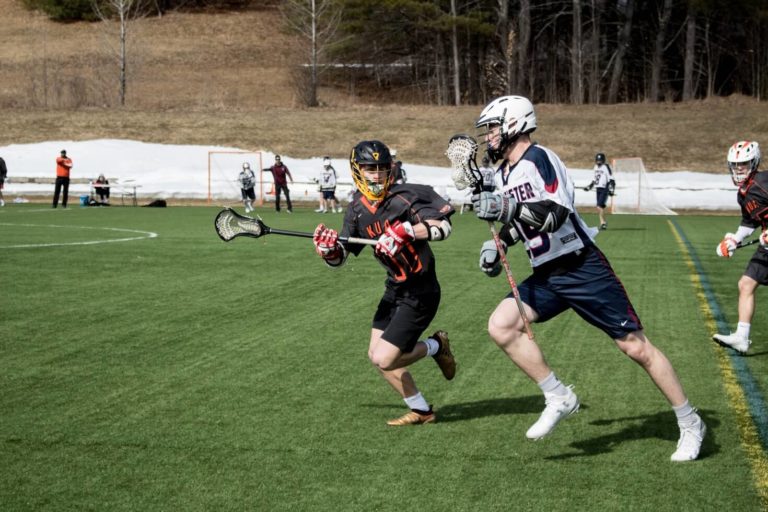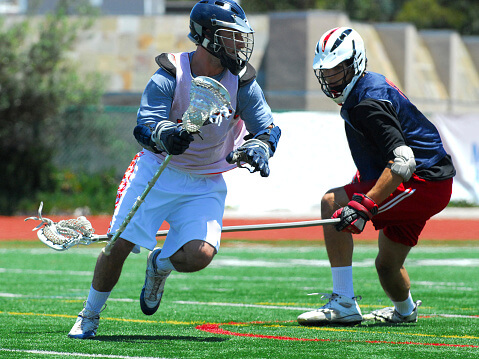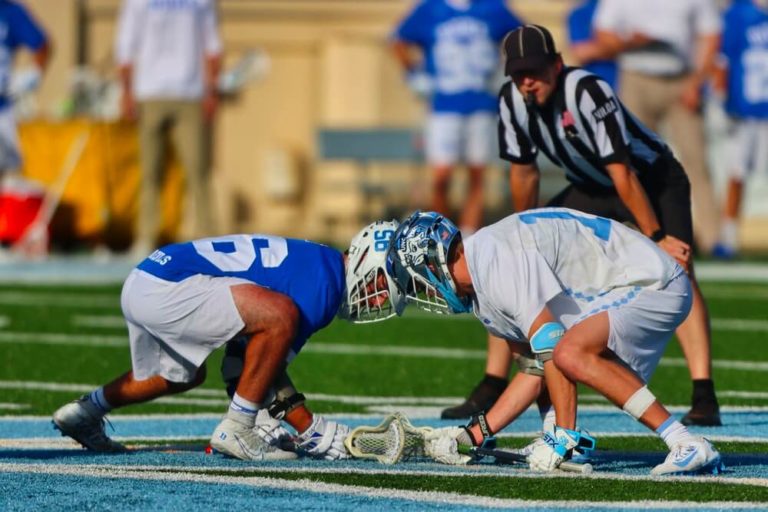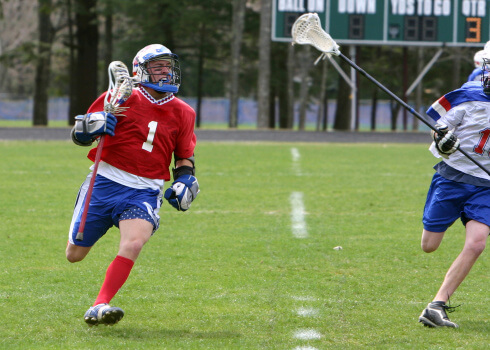The four main lacrosse positions on a lacrosse team include attackmen, midfielders, defensemen, and goalkeeper. The game of lacrosse has ten players on each team. Each team has three attackmen, three midfielders, three defensemen, and one goalie.
Players often start by choosing the lacrosse positions they are most interested in trying. As players get older (middle school and above), some coaches may suggest lacrosse positions based on the strengths and weaknesses they’ve observed. But for those new to the game, it’s recommended that players start with whichever position in lacrosse interests them the most.

Table of Contents
There are four main positions in lacrosse:
- Goalie
- Defense
- Midfield
- Attack
Within the midfield positional group, there are specialty roles, which players at competitive levels of the game (professional, college, high school, and middle school select teams) may occupy. These include:
- Long stick midfielder (LSM)
- Face-off/get off midfielder (FOGO)
- Short stick defensive midfielder (SSDM)
But the midfield specialties are not technically their own lacrosse positions. Rather, they are roles that some teams utilize to help their team gain a competitive advantage. Click on the links above to learn more about each of these specialties.
For now, we are going to examine the four basic lacrosse positions, and explore what each position entails as well as some of the characteristics and qualities that make a player well-suited for a particular position.
Goalie: The Most Important Position in Lacrosse?
Relative to other lacrosse positions, the goalie can have an outsized impact on the game. Goalies must be fearless, exhibit leadership, have fast reflexes, and be mentally resilient.
Goalies are recognized as the most important member of the team. They are the leader in charge of the defensive side of the field. At the end of the game, it’s common for coaches to instruct their entire team to run onto the field and “get your goalie” (fist bump, helmet tap, hug) as a sign of appreciation and respect.
A goalie will typically face somewhere between 20 – 30 shots from the opposing team, each game. That’s a lot of scoring chances for the opposition. A goalie who can save 60% of the shots they face versus 40% of the shots they face can mean the difference between the team consistently winning, or the team consistently losing.
Granted, the goalie is only the last line of defense and the goals the team allows do not rest solely on their shoulders. Wins and losses are never the result of a single player. Still, the goalie is the most important member of the defense and can have the largest impact on a team’s ability to stop the other team from scoring.

- Skills and Duties
- Organizing the Defense
- Making Saves
- Clearing the Ball
Organizing the defense
The goalie is the de facto leader of the defense. From their vantage point in front of the net, they are able to see the entire field, its players, and the ball. Therefore, the goalie’s first job is to organize the defense in order to stop the opposing team’s offensive.
Coaches may have their own particular terminology or nuances that they want the goalie and team to use, but a consistent rule of thumb is that the goalie should be shouting 3 things to their teammates:
- Where the ball is currently located (top right, top left, etc.)
- Who’s got ball / who’s guarding whom
- Who’s going to leave the person they’re guarding to slide to the ball carrier, if the ball carrier gets past their current defender (often referred to as the “help” defender)
In these ways, the goalie is able to orchestrate the defense to ensure that each member of the opposing team is accounted for, giving their defense the best chance of preventing a goal.
Making saves
Stopping shots taken by the opposing team is undoubtedly the most challenging part of the goalie’s job. There is only a fraction of a second for goalies to react and make the save. Technique, positioning, and hand speed are vital components to increasing the odds of saving the ball.
The goalie cannot be afraid of the ball. Getting hit by the ball is an inevitability. In fact, part of the technique that goalies are taught is how to position themselves effectively in the goal so that the shot does hit them!
But making saves is the most important part of the goalie’s job. The better the goalie is at making saves, the better their team’s chances of winning the game. Quick reflexes and very quick hands are key at this position.
Clearing the ball
After a save is made, the goalie (and the entire defense) must clear the ball. The easiest way to clear the ball is for the goalie to quickly heave the ball to a midfielder streaking up the field after they’ve made the save. Unfortunately for goalies, these opportunities to quickly pass the ball to a midfielder aren’t always available.
Once the goalie gains possession of the ball within the crease area, they have 4 seconds to survey the field and pass the ball before they must exit the crease area and attempt to clear the ball from outside the crease. At that point in time, they must work together with the rest of their team to advance the ball up the field and over the midfield line.
The goalie’s job–as well as the entire defense’s job–is not finished until the ball passes the midfield line. I.e., the ball has been successfully cleared.
Final thoughts on the goalie position
Oftentimes at the youth level, people will incorrectly assume that a player who is slightly bigger, slower, and potentially less athletic than their peers may be able to excel at the goalie position in lacrosse. This isn’t necessarily true. Fearlessness, confidence, and quick hands tend to be the best predictors of success, and successful goalies at higher levels of the game (college, professional, etc.) tend to be very athletic.
Defensemen: Keeping Opponents in Check
Defensemen assist the goalie to prevent the other team from scoring. This lacrosse position involves guarding, bodying up, and forcing attackers to take off-angle or bad shots. Defenders usually have long poles that allow them to throw stick or body checks and deny the attackers’ space to dodge and shoot. They communicate and work with their teammates and the goalie to keep the ball out of the net.
- Skills and Duties
- Communication
- Footwork
- Field Awareness

Communication
The defenders working together as a unit with the goalie need to talk to one another to prevent the attacking team from scoring. Calling where ball is and who needs to slide helps everyone work together.
Footwork
Defenders need to have a wide, low stance, quick feet and the ability to steer their attacker away from the goal. They need to be ready to react to the ball, body up their opponents and close down the attackers’ free space. Good footwork is important to being successful at this position in lacrosse.
Field awareness
Seeing the field and knowing where to be is a critical component of defense. As the ball moves quickly on offense, the defense can read the play and be two steps ahead to intercept or break up a pass or shot.
What makes a good defenseman?
A good defenseman has quick hands and feet, good footwork, communicates well, and is aggressive. Their ability to read what the offense is doing and help clear the ball out are also important. They also are good at seeing the entire lacrosse field. At the youth level, a primary defensive objective is to keep yourself between the attacker and the goal. Playing defense is a difficult but rewarding lacrosse position.
Midfielders: Hope You Like Running!
Midfielders or middies are two-way players who play offense and defense. They are responsible for transitioning the ball from defense to offense and often have the most stamina and endurance. Most teams will run “midfield lines” (like hockey) to allow each line to play in short bursts. They also tend to dodge and shoot farther out than attackers and shoot more on the run.
At the high school level and beyond, some coaches may have certain players specialize as an offensive midfielder or defensive midfielder, depending on the skills of the player and needs of the lacrosse team.
- Skills and Duties
- Endurance
- Versatility
- Transition

Endurance
In a typical game, midfielders can run 3-4 miles. Conditioning and running outside of practice enable a player to develop stamina to run the entire game.
Versatility
Midfielders must possess speed, quickness and the ability to play both offense and defense, even more so than players at the other lacrosse positions. They are often the “work horses” who do a lot of the work to pick up loose balls, run the ball out in transition, and ride to get the ball back on defense.
Transition
Moving the ball from defense to offense and riding to get the ball back are important facets of being a two way midfielder in lacrosse.
What makes a good midfielder?
Endurance, grit, toughness, work ethic and versatility define a good lacrosse middie. They run all over the field for loose balls, clear out saved shots and start a fast break or transition to offense. A fast break is started when a player is able to get a man advantage going into the offensive side of the field to give their offense scoring opportunities. They also must pay attention to staying on sides/subbing out so their team doesn’t lose possession.
For developing middies, a primary objective at this lacrosse position is to be ready to run and help your teammates in transition.
What makes a good LSM?
A good LSM is someone who picks up ground balls, defends the other teams best player, clears the ball out, create transition and ride the opponents clears.
What makes a good FOGO?
A good FOGO or “face off get off” player is one who is responsible for wining face-offs, getting the ball to a teammate and running off the field for another teammate to run on. FOGO’s hold key roles because they can give their team possession.
Attackmen: Putting Your Team Up on the Scoreboard
Attackers (also known as attackmen) are responsible for attacking and scoring goals on the opposing team’s goalkeeper. The three attackers are the most skilled ball handlers on the team who throw and catch with their lacrosse sticks on the offensive side of the field. They use dodges and fakes against defensemen on the other team to get near the goal. Their main goal is to work with their teammates to score goals by shooting the ball past the goalie.
A good attacker is someone who has great stick handling, shoots well, and is a good dodger/feeder to help their team score goals.
- Skills and Duties
- Stick Skills
- Shooting
- Dodging and Feeding

Stick skills
There are three main fundamentals that go into having the best stick skills as an offensive lacrosse player. They include catching, throwing, and cradling. Having superior stick skills enables a player to be more reliable when playing in a team setting. Having quick hands, quick feet and hand-eye coordination also help make an attacker a better overall player.
Shooting
Shooting well in lacrosse is one of the most important aspects of being a great attacker, as these players usually take more shots during the course of a game than those at other lacrosse positions. In order to be a really good shooter, a player should focus on using proper technique, accuracy over power, and working on both hands.
Technique refers to how a player holds and uses the stick to shoot. Hand placement is critical as you don’t want your hands too close or too far away. The top hand should be about halfway down the shaft with the bottom hand all they way at the bottom. Its important to stay balanced, keep the elbows and arms out away from the body and use the core to twist and follow through. Accuracy is always better than power. After all, if you miss the goal entirely, you risk losing possession.
Dodging and feeding
Dodging is a way an attacker moves to get away from their defender or to get open in space to shoot, pass, or catch. Stamina, agility, and balance are all necessary to be effective. While dodging, it’s vital to run at a speed that allows you to keep your defender off balance, maintain ball control, sell your move, and seal your defender. A few dodges to try include the roll, the face, and the split dodge. Being a good feeder entails keeping your head up, your feet moving, and your hands ready to pass.
What makes a good attackman?
A good attackman is someone who can perform all of these skills exceptionally well. Being good at dodging, shooting, passing, and protecting their stick are important, but being a good teammate and reading the defense is what separates the best attackers from the good ones. Being a good teammate means passing the ball to an open teammate rather than shooting, reading what the defense is doing, being one step ahead of the defense, and riding to get the ball back. For developing players at this lacrosse position, improving basic fundamentals such as catching, throwing and shooting can lead to more scoring.
FAQs
There are 4 main positions in lacrosse: goalie, defense, midfield, and attack.
Opinions differ on which lacrosse position requires the most athleticism. Playing goalie arguably requires the best hand-eye coordination, rapid reflexes, and footwork, so it is the position that demands the most fast-twitch athleticism. On the other hand, midfielders are typically the best conditioned athletes on the field because they run the most. Attackmen and defensemen also have their own unique athletic strengths.
Depends on who you ask! If you like to score lots of points for your team, then you’ll find attack to be the best position. If you like stopping opposing players from scoring, then defense is the best. If you like running and playing a mix of offense and defense, then midfield is the best. And if you like having a unique and indispensable role that plays a huge role in determining your team’s success, then goalie is the best position.
